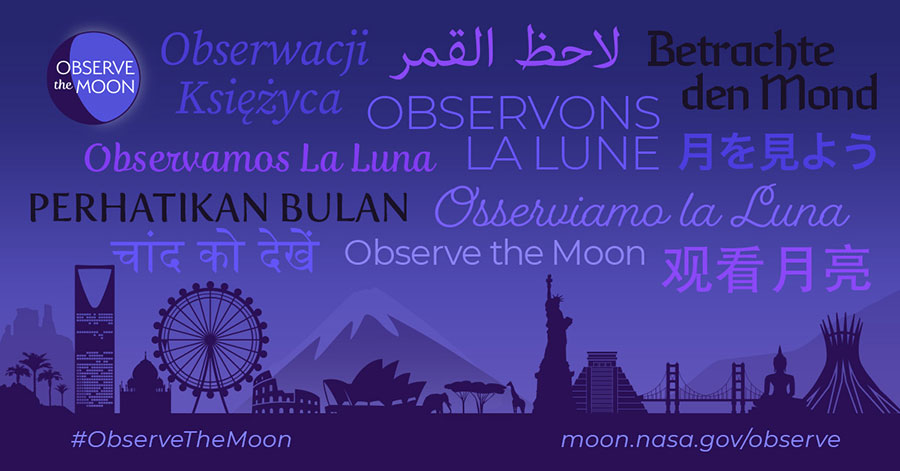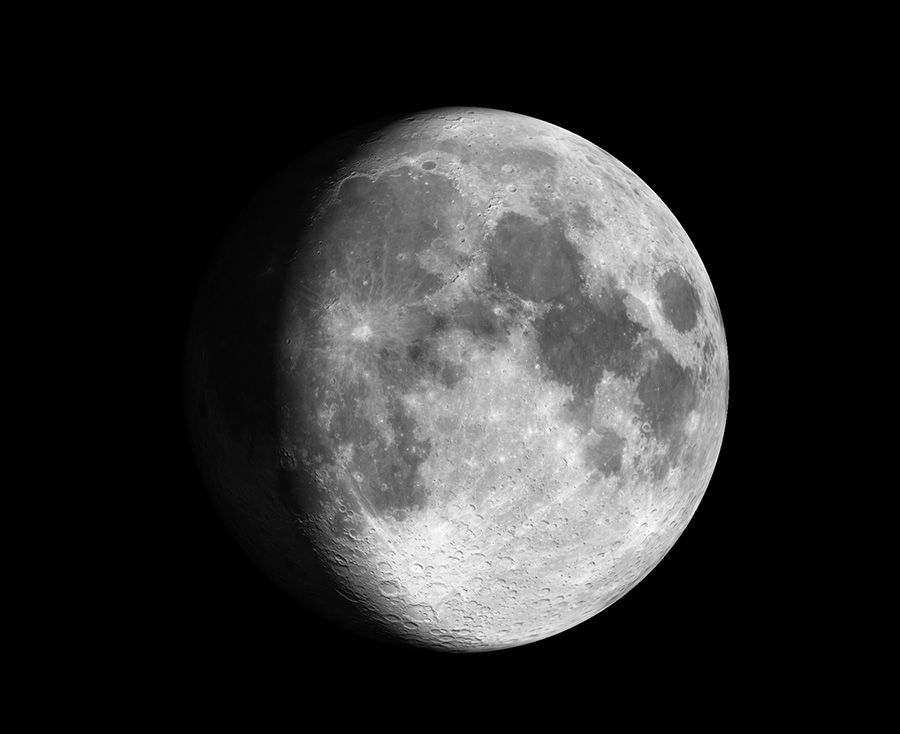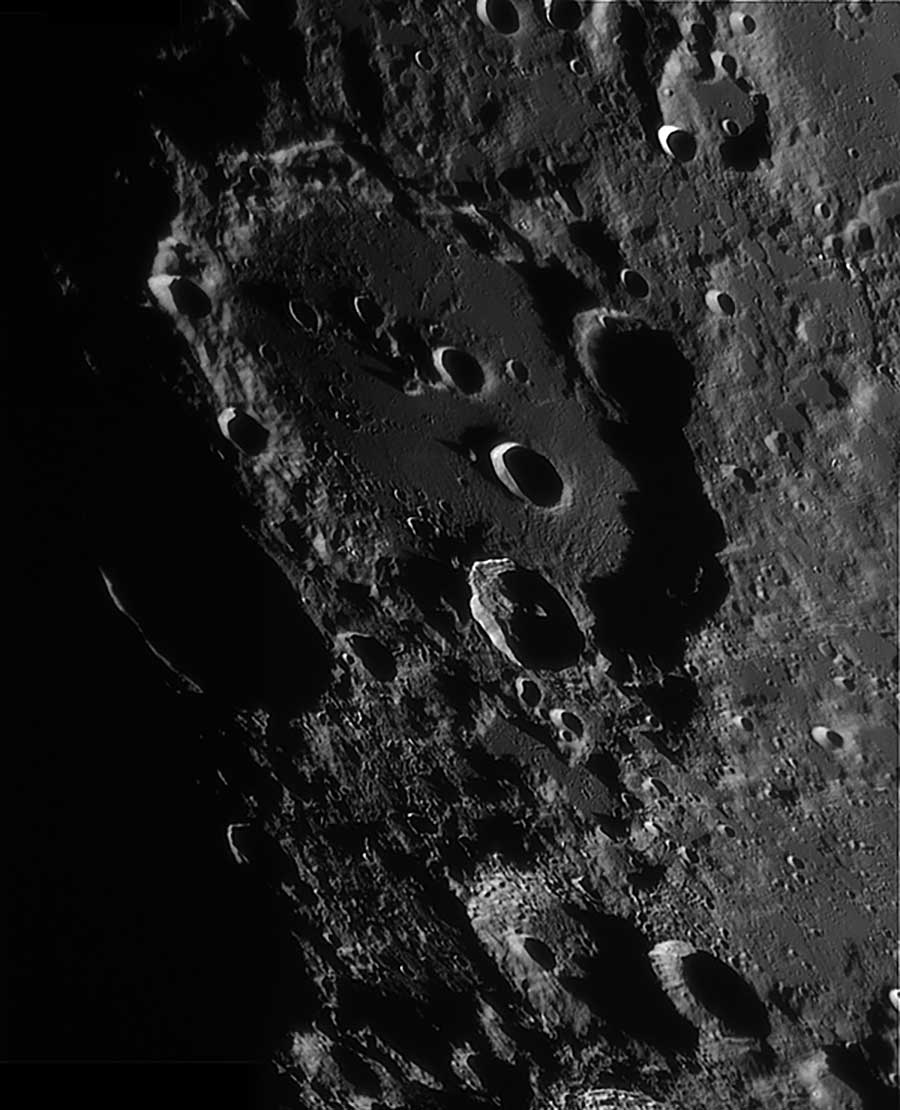Join fellow lunar enthusiasts all over the world in celebrating the Moon this weekend.
This coming Saturday, October 16th, is International Observe the Moon Night. NASA started the event in 2010 to help instill a sense of awe in our closest cosmic neighbor and to inspire us to learn more about its history and science.

the Lunar and Planetary Institute, the Planetary Science Institute, NASA's Solar System Exploration Research Virtual Institute, among others. All are dedicated to increasing our understanding of and appreciation for the Moon.
NASA / Vi Nguyen
Science museums, observatories, planetariums, and local astronomy clubs all over the world participate in bringing people together on this night. Visit NASA’s events calendar to see which of hundreds of events worldwide are planned near you. Just be aware that since we still have an ongoing pandemic, schedules may change — and make sure that if you do attend a meeting in person that you adhere to the event’s COVID safety guidelines.
International Observe the Moon Night is normally scheduled for a Saturday in September or October, as close to a first-quarter phase as possible. This Saturday, the Moon will be waxing gibbous, several days past first quarter. (Check our interactive tool to find the phases of the Moon for any day between 4000 BC and AD 8000.)
Why Observe the First-Quarter Moon?
Scheduling the event for a first-quarter Moon in the fall means that it’s high enough in the late afternoon or evening sky, when it’s already sufficiently dark for observing — people don’t have to stay up until the wee hours of the morning, and younger observers don’t have to miss their bedtimes (or the experience).
The waxing gibbous Moon is perfect for observing craters, valleys, and ridges, especially near the terminator — that’s the line between the lit and unlit portions of the Moon — where you see these features in dramatic chiaroscuro. In contrast, during a full Moon, the Sun shines directly onto the lunar surface, washing out most features.

Virtual Moon Atlas 7.0
Some observers might curse the Moon’s dazzling glow for washing out fainter stars and deep-sky objects at otherwise dark sites. But the Moon itself is a fascinating object, with a wealth of detail to explore. (And lest we forget: Without the Moon, humans would never have evolved, and we’d be denied the possibility of either admiring it or shaking a fist at it.)
Look Up!
The best thing about the Moon is that to enjoy it you need do nothing else than step outside and look up. Even in urban environments, you can see detail on the Moon’s surface. And no matter what you use to observe the Moon, you’ll find things to keep you busy for quite a while.
Among the features you’ll immediately notice with the naked eye are large, flat, gray patches. These areas are called maria, the Latin plural for “sea” (the singular is mare). In the days of yore, early astronomers mistook these patches for bodies of water, akin to those on Earth. The names stuck, though, and so we refer to, for example, Mare Tranquillitatis (the Sea of Tranquillity, the site of the Apollo 11 landing in 1969) or Mare Imbrium (Sea of Rains). These dark-gray patches came about when molten lava flooded low-lying basins.
Ordinary binoculars will show you the biggest craters, which formed when asteroids, comets, and large meteorites bombarded the Moon in the solar system’s early years. A telescope — even a small, cheap one — will bring the startling details of craters and ridges features into sharp relief. Familiarizing yourself with a Moon map will greatly enhance your enjoyment of observing it.

Sean Walker
Pay close attention to the terminator. Watch it carefully for a while, focusing on the dark side. You should see little specks of light popping up here and there. If you see one grow and merge into the lit side of the Moon, you’ve just witnessed sunlight hitting the top of a lunar mountain, sweeping down its slope, and eventually illuminating the region below.
While you’re out there, you’ll notice that as dusk deepens the Moon climbs higher in the southeast. The Moon, along with Jupiter, Saturn, and brilliant Venus form a graceful line from the southeast to the southwest. To see this sight, make sure to catch it before Venus sets (about two hours after the Sun). Also, enjoy the view of Venus less than 1½ degrees from Antares, the smoldering supergiant star in Scorpius.
Cloudy? No problem
What if it’s cloudy, I hear you ask. No worries. Several organizations are planning live-streaming events. You can head over to Gianluca Masi’s Virtual Telescope Project to enjoy the view of the Moon above the legendary skyline of Rome. The live feed is scheduled to start at 17:30 UTC (2:30 p.m. EDT / 11:30 a.m. PDT). NASA is hosting a bunch of virtual events. And Lowell Observatory will stream a live Q&A session on the Apollo 11 Moon landing, among many other lunar-related topics, starting at 7 p.m. PDT (10 p.m. EDT).
No matter how you choose to view the Moon, do take a peek on Saturday evening and stop for a moment to ponder the magnificence of our very own rocky satellite. Be moonstruck.
Further reading:
Learn more about earthshine, that soft glow on the unlit side of the Moon.
Did you know that you can catch a glimpse of the Moon’s far side? Learn how.
Find fun tips on how to observe the Moon.
If you’re curious about how the Moon formed, you can read about it in our recent post.
Get the November issue of Sky & Telescope to read more about how to view the upcoming lunar eclipse (almost total) on the night of November 18–19, 2021.
 3
3









Comments
Rod
October 15, 2021 at 2:02 pm
I did enjoy some lunar observing on the 13-Oct. Weather at my location for the weekend may have more clouds and light rain again 🙂 Here is a note from my log. [Observed 1930-2045 EDT/2330-0045 UT. First Quarter Moon 13-Oct-2021 0325 UT so the Moon tonight was just past First Quarter or waxing gibbous. I used the 90-mm refractor with 14-mm eyepiece for 71x views and true FOV a bit more than 60 arcminutes or 1-degree across. Jupiter's Great Red Spot crossed central meridian near 0149 UT, 14-Oct or 2149 EDT tonight. Io transit ended near 2353 UT tonight so when I viewed, Io very close to Jupiter's limb, < 20 arcseconds. Many cloud bands visible on Jupiter, the NEB and SEB, along with some others tonight. At Saturn, I could see some cloud bands, rings, and the moon Titan distinct. When observing the Moon, many craters along terminator line or near the terminator line like Archimedes visible, excellent details visible. After a period of clouds and light rain, this was enjoyable to view the Moon, Jupiter, and Saturn tonight. I used a Moon filter when observing the Moon. The Moon’s angular size tonight according to Virtual Moon Atlas, 31.94 arcminutes. The 4 Galilean moons were visible at Jupiter and the moon Titan visible at Saturn. Along with our Moon, that makes 6 moons viewed tonight. Jupiter retrograde in Capricornus, Saturn retrograde ended 11-Oct-2021.]
You must be logged in to post a comment.
Diana HannikainenPost Author
October 18, 2021 at 4:38 pm
Hi Rod,
Excellent! Thank you so much for sharing your recent observations in such detail!
Diana
You must be logged in to post a comment.
Rod
October 19, 2021 at 6:48 am
Thanks Diana. I posted a bit more on lunar observing here, https://skyandtelescope.org/astronomy-news/this-weeks-sky-at-a-glance-october-15-23/
I was able to view the Moon better on 17-Oct vs. 16-Oct. 129x views. I find Virtual Moon Atlas, Stellarium, and Starry Night useful tools---Rod
You must be logged in to post a comment.
You must be logged in to post a comment.